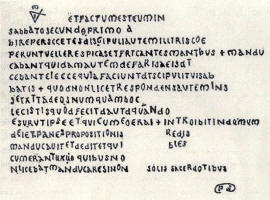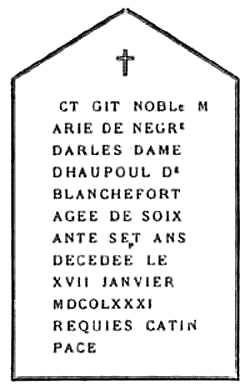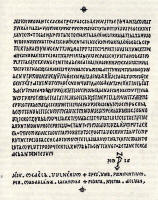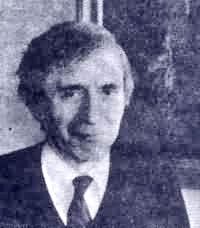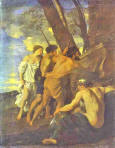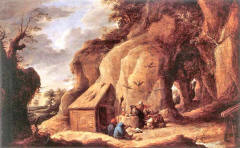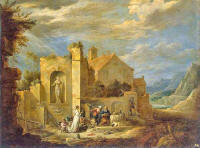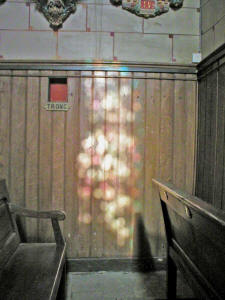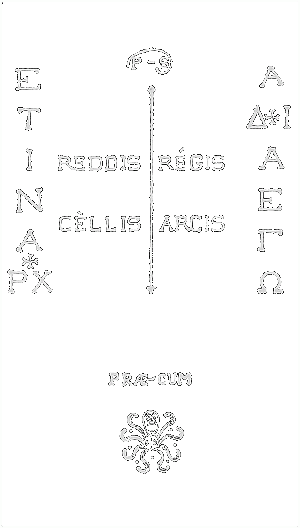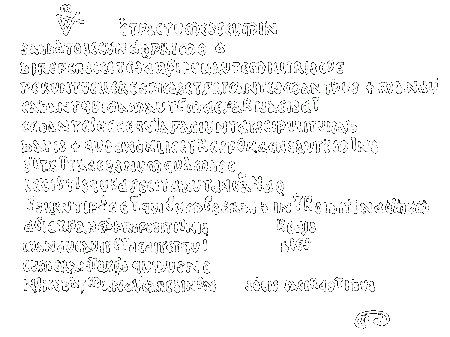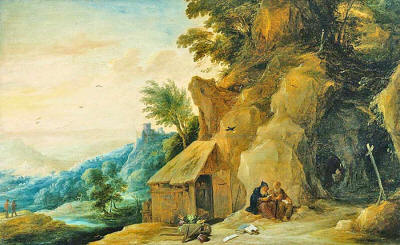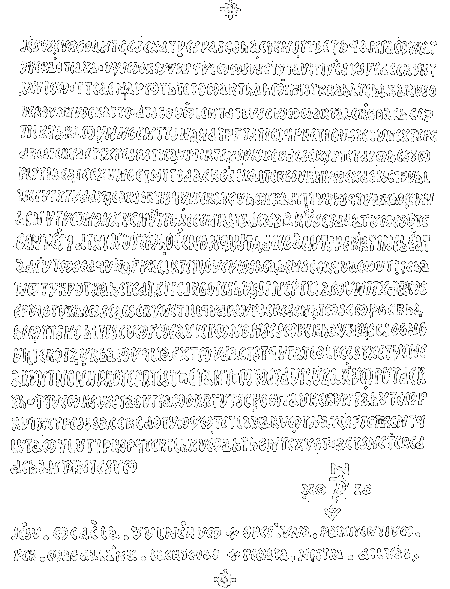|
Reading Between The Lines: The Parchments by Mark Naples from MysteryTV Website
This is perhaps the aspect of the Rennes-le-Château
mystery that has attracted the most interest - and the most
controversy.
The parchments were said to contain genealogical information
relating to the survival of
the Merovingian bloodline, and extracts
from the Gospels in Latin that contained coded messages.
It is claimed that they were acquired by a group of British
businessmen - with connections to the intelligence services - and
were locked away in a London bank vault until the late 1970s. This
aspect of the mystery is currently the subject of a Mystery.TV
documentary project.
How de Sède came by them
is not known for certain - he would only say that he was given them
by someone closely connected with Rennes-le-Château. It has been
speculated that this was either Noël Corbu or Pierre Plantard.
THE 'DAGOBERT'
PARCHMENT
The hidden message was discovered by Henry Lincoln in 1969. Some of the letters are raised above the rest on the line, and simply reading them in order gives the words:
In translation:
Some have read 'il est la mort' as 'it
is death'. This reading is possible, but 'he is there dead' is the
more obvious meaning to a French reader.
The tombstone of the
Dame d'Hautpoul
THE 'SHEPHERDESS'
PARCHMENT
smaller than the rest - which spell the
words REX MUNDI, Latin for 'King of the World', a term used by
Gnostic heretics such as
the Cathars.
This is at least readable, even if we
are no wiser as to what it means.
It requires an unnecessary number
of steps, each of which is purely arbitrary, the whim of whoever
devised it.
For
example, one of the keys to the Vigenère Square is the entire text
of Dame Marie's headstone plus nine letters taken from another
inscription - all of which is written backwards! Not even the most
brilliant codebreaker would think to try this, let alone the use of
the knight's tour and the other steps in the decoding process.
In the case of the parchment message,
whoever encoded it must have expected it to be found by someone who
knew how to decipher it - i.e. someone who had been told what the
steps in the decoding process were, and what key words and phrases
are needed. This means that the coder must have communicated the
decoding process to them. In which case, why didn't they send the
message as well, rather than hiding it inside the altar of Rennes-le-Château
church?
However, if so then they must already know what those secrets are - which makes the parchment superfluous!
Philippe de Chérisey
To compound the confusion, Philip de Chérisey, an associate of
Pierre Plantard's who many believe was involved in the creation of
the Dossiers secrets, later claimed that he had devised this message
and the parchments in the early 1960s.
In English:
Gardent la clef is often translated as 'hold the key', but this introduces a double meaning that doesn't work in French and which could lead English-speaking researchers astray.
For example, it has been suggested that it is a reference to
a painting of someone holding a key. Garder means 'to guard' or
'to
keep', but not literally 'to hold'.
.The
other references, to 'the cross', 'the horse of God',
the 'guardian demon' - and especially 'blue
apples' - are open to many interpretations.
(Blue Apples at
Midday) on 17 January 2005
and
The
Sauniere Parchments from HiddenMysteries Website
One of the foremost clues in the Rennes-le-Chateau mystery is the Blanchefort tombstone.
On the sides of the stone, as we know, the message "Et in Arcadia Ego" is inscribed, using a mixture of Greek and Latin letters. Potential interpretations of this phrase are analyzed at length in the article "The Real Meaning of 'Et in Arcadia Ego". It is also interesting that the word "Arka" is used in certain apocryphal accounts of the life of Cain to denote the region to which Cain and his descendants were banished by God, and its location was said to be in the center of the Earth.
And the word "Arcadia" applies to the Greek notion of Paradise and the Golden Age, while the word "Etin" (the first four letters in the phrase) was once an alternate spelling of "Eden", the Judeo-Christian notion of Paradise and the Golden Age.
But on the Blanchefort tombstone, the message actually reads:
The words "Arx" and "Adia" are separated so as to emphasize "Arx."
This word, in Latin, means "a fortress, citadel, or stronghold." Thus, this message may be specifically referring to a man-made structure, perhaps a temple, buried beneath Rennes-le-Chateau. This leads us directly to the message "Reddis Regis Cellis Arcis" in the center of the stone.
The word "Reddis" is supposed by most researchers to be derived from the old name of Rennes, which was once called "Rhedis", "Redis", or "Rhedae." Meanwhile, "Rennes" means "reins", and may perhaps be a name derived from the belief that Cain was imprisoned or shackled within the Arka.
But "reddis"
is also a Latin word meaning "you return" or "you restore", from
which the French "rendre" and the English "render" are derived.
"Regis" means "royal, "Cellis" means "a basement or cave", and "Arcis"
means the same thing as "Arx": a fortress, or an "ark", in the sense
of a box or enclosure.
Even the person whose grave the stone was supposedly made for, Marie de Negre de Blanchefort, whose name means "Black Marie of the White Fort", appears to be used in this context as a symbol of the goddess archetype of Isis, queen of the Golden Age.
The Blanchefort Tombstone
The letters "P" and "S" are at the top of the stone, surrounded by a Fibonacci spiral.
The same "P", "S", and spiral can be found at the bottom of Sauniere's first parchment. These letters, presumably, stand for "Priory of Sion." At the bottom of Parchment Two, the word "SION" is spelled backwards, and the "O" has a dot in the middle, causing it to resemble the astrological sign for the Sun.(1) As I looked at these clues again, I began to see the secret which these clues pointed to.
A pertinent line from Le Serpent Rouge reads:
I wondered if this line, the
"P", "S", and spiral, as well as the word "SION" spelled backwards
were all clues telling me to transpose the letters in the words "Prieure
de Sion."
Does this mean that the term "Prieure de Sion" is itself a clue indicating the idea of Paradise (the Garden of Eden) and the true Mt. Sion (the metaphorical World-Mountain in the center of the Earth) are located in the Pyrenees?
It certainly seems so.
Parchment 1
The message of the second parchment also took on an enhanced meaning now that I knew what I did.
The words "Shepherdess - No Temptation; that Poussin and Teniers hold the key" are perhaps the most straightforward aspect of the message. "Shepherdess" and "Poussin", as we know, refer to Poussin's painting, The Shepherds of Arcadia.
The "key" that Poussin has
embedded into this painting is the imagery of the tomb and Arcadia,
coupled with the landscape that clearly matches that of Arques, near
Rennes-le-Chateau, and of course, the hidden pentagram. So the
painting is telling us that the sacred "Arka", the tomb of a
long-lost god, is located near Arques, and within a pentagram - the
mountains of Rennes-le-Chateau - and is the location of Paradise, or
Arcadia.
The image of a skull and a crucifix obviously implies Golgotha, and the fact that the life-size skull dwarfs the miniature crucifix implies the giant skull of Adam after which Golgotha, the location of the Cave of Treasures, was originally named.
The painting shows one saint
pointing up towards a descending dove that is carrying the holy
host, a representation of the Grail stone.
Parchment 2
What does "Pax 681" mean? I have heard
an explanation of it from someone who claims inside knowledge, but
since I have no confirmation of this, I will leave it unreported for
now.
Le Serpent Rouge also makes mention of "divine horsemen of the abyss." Are we talking about the "abyss" of the celestial sea? Or the abyss of the Cave of Treasures?
Both possibilities seem likely.
Midday, as we
have seen, has had ritualistic significance in the religious life of
man for thousands of years, because it was when the Sun was at its
highest point.
Therefore, the apple
symbolizes the sin that caused the Fall, and as we have said, we
believe that the story of the Fall represents the same historical
event as the Deluge.
That is, they were unlawfully mixing their
sacred, royal blood with that of commoners. So this, then, is the
sin that the apple which Eve ate actually represents. And since
royal blood is referred to often as "blue blood", is seems to me
that the words "blue apples" are referring specifically to the
sinful breeding practices that are thought to have led to the
Fall/Deluge.
The way Henry Lincoln and other authors choose to interpret this, "Redis" means "Rennes", and "Bles" means "corn", which is what wheat was called in Europe and England prior to the discovery of maize, now also called "corn", in the New World. "Bles" ("corn") is also a local idiom for "money" or "treasure", like "bread" is in English.
"Solis" means "solely", and
"sacerdotibus" means "initiated."
But as we have established, "Redis" also means "return", and wheat ("corn") was also a symbol of Cain, who was thought to be the inventor of the plough, and the first to introduce the crop's cultivation.
In fact, Cain's name actually means "grain." Furthermore, wheat, and the bread that is made from it have been important icons in religious rituals throughout history, ranging from the Greek and Babylonian mysteries to ancient Judaism and modern Christianity.
Catholics celebrate communion by
eating a wafer that represents Christ's body, and the ancient Jews
had a special "shewbread" that was only administered to the Levitic
caste of priests during certain rituals. "Solis" also means "Sun",
and "sacerdotibus" specifically means "priesthood."
We do appear to be on the right track with this interpretation, for the very text into which the code of Parchment One has been inserted is a conglomeration of quotes from three of the Gospels describing a scene in which Jesus and his disciples are walking through a cornfield, eating corn! As The Gospel of Saint Matthew describes it:
So this is the "corn" that is "only for the priesthood."
But what lies beneath the symbolism of this story, and what statement is being made by connecting it with the phrase "Redis Bles Solis Sacerdotibus"? Is the parchment's creator saying,
And what of the last line in the passage from Matthew:
If its use in the parchment is a reference to Rennes-le-Chateau, this could mean that Rennes-le-Chateau is a much holier place than the remains of the temple in Jerusalem.
There may even be a message
buried in the reference to King David sharing in the shewbread of
the priests - a comment on the fact that Christ was seen as both
priest and king, a product of the royal line of Judah and the
priestly line of Levi.
Now "sal" could represent "sulfur", which characterizes one of the earliest stages of the alchemical process, while bread could represent the end result of the alchemical process, the Philosopher's Stone, just as the shewbread does in religious rituals.
But why would "Panis" ("bread") be written next to the Alpha symbol, and "Sal" ("salt") be written next to the Omega symbol, if salt is the beginning of the process and bread is the end? Perhaps, as we have theorized earlier in this book, the Alpha and Omega symbols are used by the Priory of Sion to symbolize the world before and after the Flood, or before and after the Fall from the Garden of Eden.
The bread, then, could be seen as
a symbol of the Earth's fruitful generation, while the salt
represents the infertility of the land experienced after the
cataclysm, when the land had been inundated with saline ocean water.
Perhaps, then, this is another level of meaning to the abbreviation
"P.S." - "Panis Sal."
Henry Lincoln has chosen to recombine these words into "Ad Genesareth", meaning "Towards Genesareth", the latter being a town on the coast of the Sea of Galilee (an inland lake where many New Testament stories took place).
Indeed, the Sea of Galilee is sometimes called "Lake Genesareth."
But since the words were split up in the parchment in a particular way, it seems to us that were meant to look at the meaning of the individual syllables. "Genes" could be short for "Genesis", while "Areth" could be taken to mean "Ararat." The word "genesis" means "beginning" or "generation." "Ararat" means "high holy place", and of course indicates the mount upon which Noah was saved from the Flood.
So we could recombine the phrase to say "Ad Genes Areth", which would basically mean,
The code of Parchment Two is made using a passage from The Gospel of Saint John, Chapter 12, verses 1-7. Shortly after Christ raises Lazarus from the dead, he is having dinner with Mary of Bethany (thought by some to be the same as Magdalen), Martha, Lazarus, and his disciples.
Mary takes "a pound of ointment of spikenard, very costly", and anoints Christ's feet with it, "wiping his feet with her hair."
Judas Iscariot, disgusted at the waste of something so valuable, remarks,
The passage continues:
The scene this passage describes is also illustrated in a stained glass window on the ceiling behind the altar of Sauniere's church. What could its significance be in this context?
The anointing of Christ's feet by Mary has been described by some authors as the ritual anointing of a king by his bride and queen, which we find perfectly reasonable. But Jesus specifically says that, "against the day of my burial hath she kept this", indicating that it was meant to anoint his dead body before it was placed in the tomb.
Was this tomb in Rennes-le-Chateau?
|

